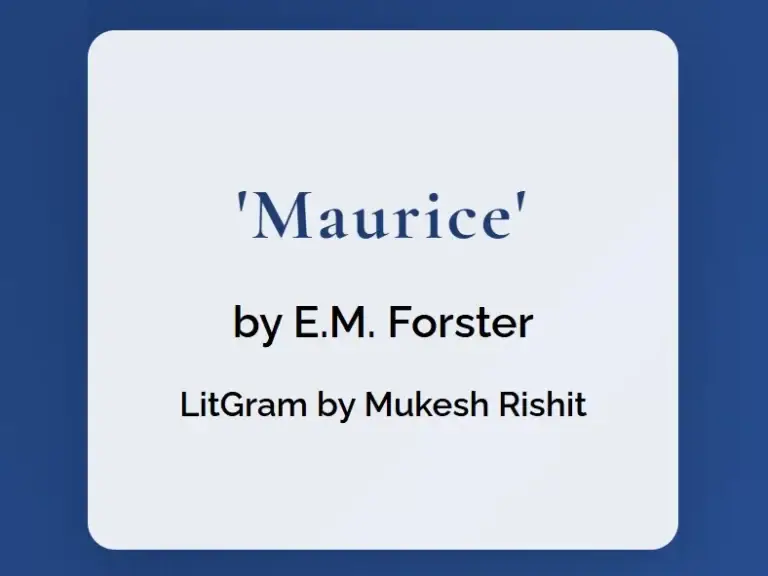There are few novels that have captured the complexities of love, societal norms, and individual identity quite like Maurice by E. M. Forster. Initially written between 1913 and 1914 but not published until 1971, a year after Forster’s death, the novel is a groundbreaking work that explores same-sex love in a society where homosexuality was not only taboo but illegal.
Historical Context and Background of Maurice
The early 20th-century social milieu was one of strict societal norms and rigid class structures. In the place where Forster wrote, homosexuality was criminalized following the Labouchere Amendment of 1885. The public discussions on sexuality were significantly centered around the concept of morality sourced from Victorian ethics, making the topic extremely sensitive and controversial.
Forster, a person of the time but with a mind far ahead of them, was impelled and motivated by his own experiences and relationships. The novel got the first impetus as a very personal contemplation on the inner battles and the repression he encountered as a result of his own sexuality.
To write about a love between two men in this ravaging environment was both reckless and risky. Forster was afraid of the effects on his career and personal life, therefore he decided to keep his manuscript hidden and to order that it would not be published until after his death. This decision emphasizes the societal expectations and the personal conflicts that LGBTQ+ persons had to confront during that period.
E. M. Forster: A Brief Biography
Edward Morgan Forster was born on January 1, 1879, in London. Forster’s childhood was overshadowed by his father’s demise when he was very young. He had a relationship with his mother that was really close, and it was her influence that shaped his views and literature. Forster went to King’s College, Cambridge, where he was exposed to an intellectual climate that was supportive of his becoming a writer.
His most significant books are:
- A Room with a View
- Howards End
- A Passage to India
Each of these novels argues with themes of class, social conformity, and personal freedom, showing Forster’s keenness in his contemporary social problems.
Forster was a quite reserved person, and only after his demise did people discover his homosexuality. His relationships with and friendships, especially with the Bloomsbury Group, contributed a lot to him developing his abilities as a writer as well as to him becoming an individual struggling with identity issues.
Summary of Maurice
In the novel Maurice, the story of Maurice Hall, a young man who deals with his sexual identity against the backdrop of a strictly-regulated society of the early 20th century England is described. The narrative begins with Maurice in his adolescent years, along with his friendship with Clive Durham, his schoolmate who becomes the object of his love, and their subsequent romance. Their profound emotional bond notwithstanding, societal pressures eventually drove Clive to choose another woman for a socially acceptable marriage.
Heartbroken and disenchanted, Maurice embarks on a road to self-discovery through a conflict with the norms of the society and his desires. The milestone is achieved thanks to the relationship he has with Alec Scudder, who is a gamekeeper. Dissimilar to the connection he had with Clive, the relation he shares with Alec is based on both the attraction of the bodies and emotional truth, thus, it reaches a liberating and optimistic end.
Themes Explored in Maurice
The Quest for Personal Authenticity
At its very essence, Maurice is essentially a chronicle of the main character’s self-discovery and the fight for the right to be himself. Maurice’s odyssey from following the path of societal conformity to living the life of true selfhood is a powerful tale that has resonance with all those who faced the dilemma between reality and external pressures.
Societal Norms and Their Constraints
The novel is a deep and striking critique of the social constructs that hinder individual freedom. Focusing on the relationships Maurice shared, the author using the character of Forster’s disclosing the hypocrisy and rigidity of the social fabric which privileging conformity over authenticity.
Class Struggle
The class warfare that permeates the tale of Maurice is woven intricately into the character’s lives. Maurice’s bond with Alec, who was from a lower class, shakes the class lines that divide them. Their bond is not only a breaking of the rules related to the sexual orientation but also a tagging of the class expectations.
Character Analysis
Maurice Hall
Maurice Hall is the lead character around whom the plot is centered. He is initially depicted as just another typical outcome of his deeply-rooted social environment but as the plot proceeds, he undergoes a massive transformation as he struggles with his desires, societal restrictions, and emotional needs.
Clive Durham
Clive is well-known as the best friend and first love of Maurice. As an aristocratic figure, Clive stands for the ideals and pressures of society that eventually lead him to hide his feelings and get married to a woman instead of being true to himself, demonstrating the conflict personal wishes have over social norms.
Alec Scudder
Alec is the gamekeeper with whom Maurice reaches emotional and physical companionship that is true. In contrast to Clive, Alec is very open about what he wants, he does not care about what people say or think; thus, his character reflects the message of authenticity and hope contained in the book.
Narrative Techniques
Using omniscient narration, Forster captures the third person’s perspective, allowing readers to survey Maurice’s struggles both internally and externally. This technique facilitates the comprehension of the characters’ intricacies and the context of the society where they live.
Symbolism and motifs, as previously wonderful examples, are used to reinforce themes of individual liberation and fake societal expectations. The differences in settings of the city and the countryside that symbolize the disintegration between society norms and personal freedom are also used here.
Maurice’s Relationship with Clive Durham
Maurice and Clive’s relationship lies in the center of the first part of the story. Their bond starts as a connection of deep intellectual and emotional nature that goes on to romantic love. However, Clive’s opting for societal obligation via marrying a woman crushes Maurice, marking a crucial plot twist.
Maurice’s Evolution and Self-Discovery
Maurice’s road to acceptance is depicted through crucial events, including his bond with Clive, followed by his eventual bond with Alec. These relationships offer vantage points for Maurice, allowing him to discover and embrace who he really is.
Maurice’s Relationship with Alec Scudder
The central feature of Maurice and Alec’s relationship is mutual desire coupled with emotional candor. Unlike the cerebral and constrained bond with Clive, the link with Alec is based on physical attraction and the realization of their shared liberation, living up to Forster’s premise of a utopian homosexual couple.
Forster’s Vision of Same-Sex Love
Forster’s resurfacing of same-gender love, in the book Maurice, is electric and encompassing for the future perspective he gives. Not like the traditionally tragic outcomes of queer literature at that time, the author suggests a brighter future where same-sex love can exist and flourish irrespective of societal impositions.
Reception and Legacy
Maurice was published posthumously and got both positive and negative reviews. While some noted that the book was a brave foray into exploring same-sex love, others were angry about its exhibition of sexuality. Over the decades, the book has come to be regarded as one of the most important LGBTQ+ sex works, having inspired many writers and readers.
Adaptations and Cultural Impact
The 1987 movie Maurice, directed by James Ivory, popularized the book to an even greater extent and further consolidated its cultural impact. The novel’s influence is not only detected in literature but it also elicited discussions on different topics – identity, conformity, and sincere love.
Comparative Analysis
Structuring a comparative study of Maurice with the works of E. M. Forster like A Room with a View or Howards End would expose the repetitive themes of societal restriction and personal freedom persistently held throughout. Nonetheless, Maurice expresses itself in its fixation on homosexual love and the affirmative denouement.
Critical Perspectives
Throughout the years, Maurice has been targeted on a number of different scholarly takes including feminist and queer readings. Researchers have occupied the literary study of sexuality, class, and the search for authenticity contributing to its everlasting importance and effect.
Conclusion
The novel Maurice written by E. M. Forster can be regarded as being castles on the water, as far away from the complexities of love, self-realization, and societal mandates as it gets. Introspectively and existentially exploring the relationships between humans, besides relationships of similar gender, and the question for true self-expression, the book makes a deeply foundational remark about human life. This leaves the reader with a reflection on their own life and the society they have to live with.
FAQs
- Why was Maurice published posthumously?
Forster was afraid that society would respond negatively if he published a book concerning same-sex love during his lifetime. - How does Maurice differ from other Forster novels?
Unlike Forster’s other books, Maurice discusses sexual orientation and its societal factors in a very frank and explicit mode. - What is the significance of the novel’s ending?
When Maurice and Alec have a happy end, this overturns the usual tragic motives often applied to queer literature. - What impact did the novel have when it was published?
The book had a mixed reception, with readers praising it for its boldness and at the same time criticizing it for its candid depiction of homosexual behavior. - How has Maurice impacted LGBTQ+ literature?
Maurice is a work that is seen as groundbreaking in LGBTQ+ literature, serving as a springboard for dialogues on identity, authenticity, and societal norms.



1 Comment
Pingback: A Passage to India by E. M. Forster: A Comprehensive Critical Summary